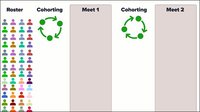In an increasingly digital world, preparing students to thrive in the future workforce is a priority that schools can no longer afford to sideline. The integration of technology into the classroom is about keeping pace with innovation and providing students with the tools they need to succeed academically and professionally. A strategic approach to technology integration is essential as school administrations look to enhance curricula. Below, I discuss how schools can best prepare K-12 students to advance academically using key technological tools and practices.
Key Technological Tools and Platforms
One of the foundational steps in enhancing academic achievement and career readiness is the integration of cutting-edge technologies into the curriculum. To truly empower students, schools must embed cutting-edge technologies into their curricula, transforming classrooms into incubators of innovation. These are fast becoming the building blocks of tomorrow’s economy.
Tools like OpenAI’s ChatGPT and Gemini can hold benefits for academic research and creative projects, provided students are transparent about their usage and diligent in fact-checking their sources. This teaches them to leverage technology responsibly and develop critical thinking skills. For students with a passion for technology, tools like Copilot should become a staple in their learning journey, normalizing the skills they’ll need to thrive in tomorrow’s digital landscape.
I recall my own experience in the late 1980s when I was exposed to AI in a groundbreaking class for 14-year-olds. We explored the potential of this emerging technology by programming simple decision tree systems. This early exposure gave me a significant advantage, as it prepared me for the technological shifts to come. Today's students deserve similar opportunities to engage with the technologies that will inevitably reshape our future.
Training Teachers to Utilize Technology
While integrating technology into the classroom is crucial, it is equally important to upskill teachers and staff to use these tools effectively. However, teachers are often stretched thin, balancing teaching, new curricula, testing standards, and other responsibilities. This leaves little time for exploring and experimenting with new technologies in a creative and meaningful way.
To address this challenge, schools will have to allocate formal time within the school calendar specifically for technology training. Bringing in industry experts for hands-on training can ignite a passion for innovation among teachers, allowing them to experiment and discover the most effective ways to integrate technology into their unique teaching environments. Moreover, teachers should be given time to experiment with different methods of integrating new technologies into their teaching. Whether it's through individual assignments, group projects, or innovative classroom activities, teachers need the freedom to explore what works best in their unique environments.
Collaboration Between Schools and Technology Companies
Preparing students for a world of technological advancement isn’t solely the responsibility of schools. Strategic partnerships with technology companies can be the key to unlocking new educational possibilities. Many companies offer programs specifically designed to support educational institutions. These programs often provide free software, online training, and certification resources that schools can readily adopt. This not only eases the burden of developing curricula and exams from scratch but also gives students industry-recognized qualifications that enhance their resumes.
However, it is crucial that the tools and resources provided by these companies align with the demands of future employers and higher education institutions. Collaborating with local universities, for instance, can ensure that the technologies students use in high school are consistent with what they will encounter in academia or real life. This continuity helps students build on their skills and gain mastery over the tools that will be essential in their professional lives.
Balancing Technology with Traditional Teaching Methods
While technology is a powerful tool for enhancing education, it is essential to balance its integration with traditional teaching methods to ensure a well-rounded education. Traditional methods, such as developing critical thinking and understanding historical context, remain vital. The challenge is to integrate these foundational skills with technological advancements in a way that enriches learning rather than replacing essential educational pillars.
That said, understanding facts and the historical context behind them remains important. If we fail to learn from the past, we risk repeating the same mistakes in the future. Therefore, schools should rely on teachers to strike the right balance between technology and traditional methods. This balance may vary depending on the school, the specific cohort of students, and the subject matter. Techniques such as group projects and competitions, where students can apply their knowledge in real-world scenarios (e.g., "Shark Tank" style presentations), can be highly effective.
Ensuring Equal Access to Technology
However, the promise of technology is only as powerful as its reach. Ensuring that all students, regardless of their background, have equal access to these technological tools is a challenge that schools must address head-on. This can be addressed by establishing computer labs that are accessible 24/7 and by creating networks of computing resources in local libraries and community centers. By moving most platforms and tools to the cloud, schools can provide students with affordable devices like Chromebooks, reducing the financial burden on families.
Relying on cloud-based tools also levels the playing field, as it reduces the need for powerful local hardware. For instance, using cloud-based design tools like Canva instead of more resource-intensive software like Photoshop ensures that all students can participate fully, regardless of their access to high-end computing devices.
Mitigating Bias in AI-Powered Educational Tools
Finally, as schools increasingly integrate AI into educational tools and assessments, it is crucial to address potential biases that could affect student outcomes and equity. While it is impossible to eliminate bias entirely—whether in human intelligence or AI—efforts can be made to minimize it. This involves reviewing and normalizing training data sets to reduce overt bias and using other AI tools to conduct exhaustive validation tests.
School administrations may not have the expertise to carry out this level of validation themselves. Therefore, it is advisable to either hire independent experts or require vendors of AI models to certify that their tools have undergone rigorous testing. Contracts should include penalties with real "teeth" to ensure compliance.
Conclusion
The integration of technology into K-12 education is vital not only for academic success but also for preparing students to navigate a rapidly evolving world. By thoughtfully incorporating technological tools, providing robust training for teachers, fostering collaborations with industry, and ensuring equal access for all students, schools can offer a well-rounded education that equips students with essential skills for the future. Balancing innovation with traditional teaching methods is key to ensuring that every student has the opportunity to succeed in this dynamic landscape. As we move forward, this strategic approach will be crucial in helping students thrive in their academic and professional journeys.
About the Author

Eugene Serial entrepreneur with experience in building successful businesses from Ground 0. Went from Customer Support to Digital Marketer to CMO to CEO. Core competencies: Digital Marketing, Operations, Analytics, People Management, Business Performance & Strategy, Fundraising.
Adam Sandman founded Inflectra in 2006 and has been programming since he was 10. Now serving as the company's CEO, Adam is responsible for product strategy, technology innovation, and strategic business development. Driven by a deep passion for education, he is dedicated to empowering teachers, students, and communities worldwide to gain a foothold in the technology economy through the Global Technology Initiative.











